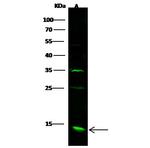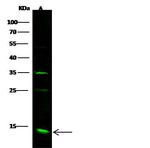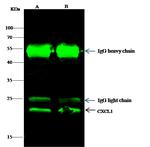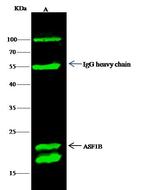Search Thermo Fisher Scientific
FIGURE: 1 / 4
CXCL1 Antibody (PA5-117897) in WB




Product Details
PA5-117897
Species Reactivity
Host/Isotype
Class
Type
Immunogen
Conjugate
Form
Purification
Storage buffer
Contains
Storage conditions
Shipping conditions
RRID
Target Information
CXCL1, CXCL2, and CXCL3, also known respectively as GRO alpha, GRO beta (MIP-2 alpha) and GRO gamma (MIP-2 beta), are members of the CXC subfamily of chemokines. Mature CXCL1/2/3 proteins bind with high affinity to the IL-8 receptor type B and are potent neutrophil attractants and activators. In vitro, the processed forms GRO-alpha(4-73), GRO-alpha(5-73) and GRO-alpha(6-73) show a 30-fold higher chemotactic activity.
For Research Use Only. Not for use in diagnostic procedures. Not for resale without express authorization.
References (0)
Bioinformatics
Protein Aliases: C Cmotif chemokine; C X C motif chemokine; C-X-C motif chemokine 1; CC motif chemokine; CCmotif chemokine; chemokine (C-X-C motif) ligand 1 (melanoma growth stimulating activity, alpha); CXC; CXC motif chemokine; CXCL; CXCL-1; fibroblast secretory protein; GRO a; GRO α; GRO-alpha(1-73); GRO1 oncogene (melanoma growth stimulating activity, alpha); GRO1 oncogene (melanoma growth-stimulating activity); GROalpha; Growth-regulated alpha protein; GROα; melanoma growth stimulating activity, alpha; Melanoma growth stimulatory activity; melanoma growth stimulatory activity alpha; MGSA; MGSA alpha; NAP-3; NAP3; Neutrophil-activating protein 3
Gene Aliases: CXCL1; FSP; GRO; GRO1; GROA; MGSA; MGSA-a; NAP-3; SCYB1
UniProt ID: (Human) P09341
Entrez Gene ID: (Human) 2919

Performance Guarantee
If an Invitrogen™ antibody doesn't perform as described on our website or datasheet,we'll replace the product at no cost to you, or provide you with a credit for a future purchase.*
Learn more
We're here to help
Get expert recommendations for common problems or connect directly with an on staff expert for technical assistance related to applications, equipment and general product use.
Contact tech support
